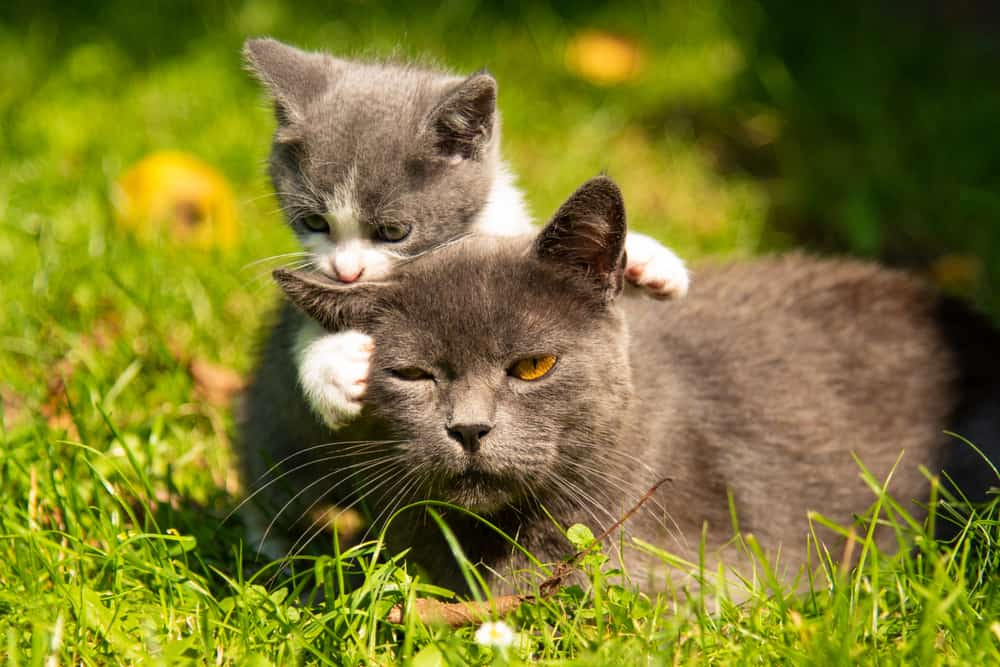Introducing Your New Kitten to Your Cat

Bringing a new kitten into your home is always an exciting prospect, but when you already have a feline best friend at home, it can instead take on a whole other level of stress. It may seem like introducing your new kitten to your cat is an impossible task that is destined to be filled with claws and hissing, but it really doesn’t have to be this way!
It is completely possible to bring a new kitten into your home without upsetting your resident cat. In this article, we will discuss the preparations you need to make before your new kitten’s arrival and the steps you should take during each part of the process. Becoming familiar with the introduction routine will allow you to expand your feline family in a relatively stress-free manner.
Why Are First Impressions So Important?
By nature, cats are territorial animals. It can be hard for your kitty to open up and realize they have to share their space, especially if they’ve been running the household alone for so long.
It is important that you take care when introducing a new kitten or older cat to your existing kitty, as changes in their environment can stress out your current cat or cause them to lash out, attacking your new kitten. This, in turn, could create a bad relationship between your cats that will take time to heal.
It is possible to make a harmonious introduction between your new kitten (or new older cat) and your current cat, but you need to make sure you are familiar with the steps and fully prepared before bringing your new kitten home, as this will make the process go the smoothest.
Steps for Introducing a New Kitten
There are several steps that you should follow during every part of this process to safely and smoothly introduce a new kitten to your cat.
Before You Bring the Kitten Home
A few days before you plan on bringing your new kitten home, set up their own personal area. This should be a space that can be completely isolated and closed off from your other cat, such as a spare bedroom or a bathroom.
Remember, it is important to isolate your cats for at least 2 to 3 days at first and watch for signs of sickness, especially if you are bringing your new kitten home from a shelter or a rescue organization. Isolation helps prevent the spread of any illness among your cats.
In this separated area, you should have everything your kitten needs to stay healthy and happy, including a litter box (your cats should have a litter box each!), food and water dishes, toys, and comfy spaces to rest on.
First Days
In the first days of having your kitten at home, you should keep them out of sight of your current cat. Take turns giving individual attention to your cats, making sure to spoil your resident kitty, especially if they are acting curious near the area where your new kitten is staying.
Scent-Swapping
During this time, you should be working on scent-swapping to get your cats used to each other’s smell. Scent-swapping involves taking a blanket, pillow, or cat bed that your new kitten has been resting on and placing it near your resident cat; you should also take something from your resident cat and put it in your kitten’s isolated area. This allows both felines to become familiar with the scent of the other and makes it possible for their scents to start mingling.
Switch the Areas Your Cats Are Allowed
After you’ve scent-swapping items several times, you can begin switching the areas your cats are allowed into. This means removing your new kitten from the isolation area and keeping them in a separate temporary location.
Let your resident cat into the isolation area and shut them in there, preferably with you or a friend keeping them company. At the same time, let your new kitten out of the temporary location and allow them to explore the rest of the home under supervision.
Once both cats have explored for a while, switch their locations back to normal (take care to not let them see each other yet!).
This action of site-swapping creates an even greater sense of scent mingling and can encourage both cats to become tolerant at the scent of the other.
After a Week
After your cats have spent some time separated (this could be several days spent apart up to an entire week), it is time to let them start seeing each other. This can be done with the help of a pet gate or some kind of screen. If you want, you can even put a blanket or towel over the gate and raise it slowly with each interaction to have complete control over the cats’ visual access to each other.
Once your cats are safely on each side of the gate, monitor them to make sure neither is trying to stare down the other or is attempting to jump over the separation. You can start feeding your cats by placing their bowls near to the gate (but not right next to it!), so they make the positive association of food with the other’s presence.
Your cats should start warming up to each other through several interactions like this, and you can start to let them out into the same spaces together once you feel they are both ready for it. Make sure to keep an eye on them during their first few interactions without a gate so you can prevent any intimidation or fighting before it happens.
Encourage Bonding Activities: The Final Step
Feline bonding is when two cats, either siblings or unrelated, develop a special affection for each other. Cats that are bonded will typically want to spend all their time together and may become upset when separated. However, encouraging bonding is an important part of getting your cats to become comfortable around each other.
In order to increase your cat’s bonding, you should try out a technique that cat behaviorist Jackson Galaxy refers to as “eat, play, love.” This technique involves bringing your cats into the same room, but distracting them both with their favorite treat or toy. This keeps them around each other, but not focused on trying to intimidate each other. They will begin to associate this positive interaction with the other’s presence, further warming your cats up to sharing spaces.
This type of interaction should be repeated until your cats can tolerate being around each other without you having to provide extreme supervision or having to end the interaction early due to the beginning of a cat fight. If you can casually stop distraction activities with each cat and have them go about their lives normally, you have succeeded in safely introducing your new kitten to your cat.
Preventing Cat Fights
As soon as your cats have made it all the way through the introduction steps, you are able to let them start sharing spaces. However, this comes with its own stress as you work to monitor your kitties and ensure there is no fighting or stare downs taking place.
During this time, it can be helpful to have a separating device to place in between the cats if it looks like they are about to get into a fight. This can be anything – a large piece of cardboard, a blanket, or a pet gate; just make sure that it cuts off your cats’ line of sight to each other and that it will resist a cat’s potential attack if they throw themselves at it.
Once you have lowered the separating device, you should isolate the cats and give them time to cool down before attempting another round of introductions.

Pro Tips for Introducing a Kitten to Your Cat
These pro tips can help your kitten introductions go smoothly and keep your resident cat calm during the process.
Try Calming Pheromones
Spraying some calming cat pheromones on the surfaces in your home right before you bring in your new kitten can help your current cat feel calmer and more receptive to the new scent in their environment. Just make sure not to spray the pheromones too close to the area that your new kitten is in, because you do want your current cat to get a smell of them as part of the introduction process.
Provide Safe Spaces
Make sure that you have safe spaces in both the new kitten’s isolated area and the area your current cat is in. This will give them areas that they can run and hide to when they feel overwhelmed.
It is a good idea to keep these spaces in place even after your cats warm up to each other just to provide them each with their own personal safe areas.
Don’t Rush Things
The worst thing you can do in a cat introduction is rush the situation and immediately let your new kitten run free around your home. This will stress your resident kitty out and can encourage fights between the two cats, which is not great for a first impression.
Follow the introduction process methodically, only moving on to the next step when you feel like both cats are ready for it. Putting more time in up front will make the introductions go smoothly and can create a stronger bond between your cats.
Reward Positive Interactions
Any positive interactions your cats have, such as sniffing at each other under doors or having visual access to the other without growling, should be rewarded with treats and attention.
This encourages your cats to start making a positive association with the presence of the other and can lower their stress levels.
Avoid Free-Feeding
You should avoid free-feeding your cats, at least during the first few weeks of their lives together, as structured mealtimes taken together provide more of an opportunity for your cats to bond. Feed your cats on either side of the isolated area at first and work up to feeding them on either side of their visual access gate.
The last level of this is to feed them at the same time in a shared space during bonding activities. This allows your cats to become familiar with the scent of one another as they eat.

A Stress-Free Addition to the Family
Introducing a new kitten or older cat to your existing feline friends can be a stressful activity. With all the unknowns about whether your cats will like each other or if they will instead engage in daily fights, it can be hard to even decide to bring a new cat home.
Fortunately, as long as you take the process slow and follow some of our pro tips for smooth introductions, you’ll be well on your way to making a stress-free addition to your feline family.




